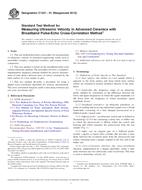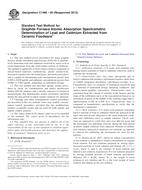Potřebujeme váš souhlas k využití jednotlivých dat, aby se vám mimo jiné mohly ukazovat informace týkající se vašich zájmů. Souhlas udělíte kliknutím na tlačítko „OK“.
ASTM C1332-01(2013)
Standard Test Method for Measurement of Ultrasonic Attenuation Coefficients of Advanced Ceramics by Pulse-Echo Contact Technique
Automaticky přeložený název:
Standardní zkušební metoda pro měření Ultrazvukové útlumových koeficientů pokročilých keramiky Pulse-Echo Kontakt Technika
NORMA vydána dne 1.2.2013
Informace o normě:
Označení normy: ASTM C1332-01(2013)
Poznámka: NEPLATNÁ
Datum vydání normy: 1.2.2013
Kód zboží: NS-10733
Počet stran: 12
Přibližná hmotnost: 36 g (0.08 liber)
Země: Americká technická norma
Kategorie: Technické normy ASTM
Kategorie - podobné normy:
Anotace textu normy ASTM C1332-01(2013) :
Keywords:
attenuation coefficient, attenuation spectrum, material microstructure, materials characterization, monolithic ceramics, nondestructive evaluation, polycrystalline metals, pulse-echo technique, structural composites, ultrasonic attenuation, ultrasonics, ICS Number Code 81.060.30 (Advanced ceramics)
Doplňující informace
| Significance and Use | ||||||||||||
|
5.1 This test method is useful for characterizing material microstructure or measuring variations in microstructure that occur because of material processing conditions and thermal, mechanical, or chemical exposure (3). When applied to monolithic or composite ceramics, the procedure should reveal microstructural gradients due to density, porosity, and grain variations. This test method may also be applied to polycrystalline metals to assess variations in grain size, porosity, and multiphase constituents. 5.2 This test method is useful for measuring and comparing microstructural variations among different samples of the same material or for sensing and measuring subtle microstructural variations within a given sample. 5.3 This test method is useful for mapping variations in the attenuation coefficient and the attenuation spectrum as they pertain to variations in the microstructure and associated properties of monolithic ceramics, ceramic composites and metals. 5.4 This test method is useful for establishing a reference database for comparing materials and for calibrating ultrasonic attenuation measurement equipment. 5.5 This test method is not recommended for highly attenuating monolithics or composites that are thick, highly porous, or that have rough or highly textured surfaces. For these materials Practice E664 may be appropriate. Guide E1495 is recommended for assessing attenuation differences among composite plates and laminates that may exhibit, for example, pervasive matrix porosity or matrix crazing in addition to having complex fiber architectures or thermomechanical degradation 1.1 This test method describes a procedure for measurement of ultrasonic attenuation coefficients for advanced structural ceramic materials. The procedure is based on a broadband buffered piezoelectric probe used in the pulse-echo contact mode and emitting either longitudinal or shear waves. The primary objective of this test method is materials characterization. 1.2 The procedure requires coupling an ultrasonic probe to the surface of a plate-like sample and the recovery of successive front surface and back surface echoes. Power spectra of the echoes are used to calculate the attenuation spectrum (attenuation coefficient as a function of ultrasonic frequency) for the sample material. The transducer bandwidth and spectral response are selected to cover a range of frequencies and corresponding wavelengths that interact with microstructural features of interest in solid test samples. 1.3 The purpose of this test method is to establish fundamental procedures for measurement of ultrasonic attenuation coefficients. These measurements should distinguish and quantify microstructural differences among solid samples and therefore help establish a reference database for comparing materials and calibrating ultrasonic attenuation measurement equipment. 1.4 This test method applies to monolithic ceramics and also polycrystalline metals. This test method may be applied to whisker reinforced ceramics, particulate toughened ceramics, and ceramic composites provided that similar constraints on sample size, shape, and finish are met as described herein for monolithic ceramics. 1.5 This test method sets forth the constraints on sample size, shape, and finish that will assure valid attenuation coefficient measurements. This test method also describes the instrumentation, methods, and data processing procedures for accomplishing the measurements. 1.6 This test method is not recommended for highly attenuating materials such as very thick, very porous, rough-surfaced monolithics or composites. This test method is not recommended for highly nonuniform, heterogeneous, cracked, defective, or otherwise flaw-ridden samples that are unrepresentative of the nature or inherent characteristics of the material under examination. 1.7 This standard does not purport to address all of the safety concerns, if any, associated with its use. It is the responsibility of the user of this standard to establish appropriate safety and health practices and determine the applicability of regulatory limitations prior to use. |
||||||||||||
| 2. Referenced Documents | ||||||||||||
|
Podobné normy:
Historická
1.8.2013
Historická
1.8.2008
Historická
1.8.2012
Historická
1.12.2010
Historická
1.1.2009
Historická
1.4.2012



 ASTM C1326-13
ASTM C1326-13 ASTM C1327-08
ASTM C1327-08 ASTM C1331-01(2012)..
ASTM C1331-01(2012).. ASTM C1337-10
ASTM C1337-10 ASTM C1378-04(2009)..
ASTM C1378-04(2009).. ASTM C1466-00(2012)..
ASTM C1466-00(2012)..
 Cookies
Cookies
